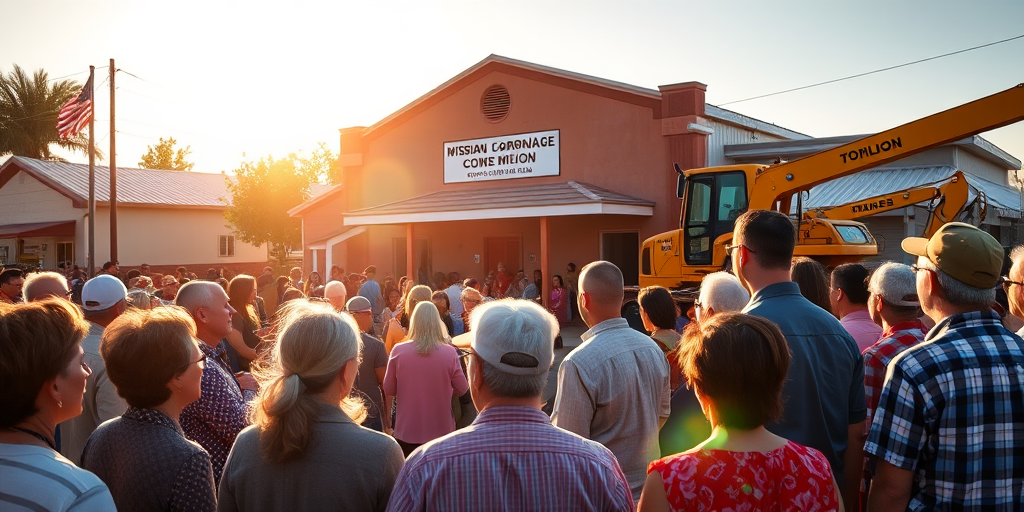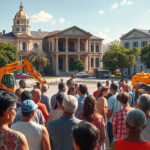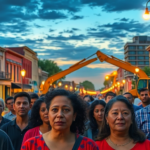City of Mission Announces Call for Bids on $2 Million Drainage Projects
The City of Mission, Texas, is taking significant steps to address persistent flooding issues by initiating a call for bids on two major drainage projects. The projects, valued at a combined $2 million, aim to improve infrastructure and prevent flooding for approximately 2,000 homeowners, showcasing a commitment to enhancing the quality of life for Valley residents in the Rio Grande Valley (RGV).
Project Overview and Funding
Announced on Monday, these drainage projects are set to mitigate recurring flooding problems in neighborhoods south of the expressway and near Castro Elementary School. The initiative is largely funded by a $2 million grant from the Texas General Land Office, supplemented with an additional $20,000 from the city itself.
According to Mission’s Assistant City Manager, Juan Pablo Terrazas, the projects will involve creating drainage ponds capable of holding a combined 7 million gallons of water. “We are dealing with a considerable difference in elevation between Business 83 and the surrounding areas, with up to 24 feet elevation discrepancies,” Terrazas explained. “This results in significant water accumulation along the expressway, which these projects aim to remedy.”
Details of the Drainage Projects
The first initiative, known as the La Cuchilla Drainage Project, will focus on areas south of the expressway, specifically from Los Ebanos to La Cuchilla Circle. This project is strategically designed to manage water flow and prevent it from affecting local homes and streets.
Meanwhile, the second project, referred to as the Astroland Project, will concentrate on improving drainage around Castro Elementary School located on the 200 block of Mayberry Street and its environs. Both projects are anticipated to enhance road safety and residential conditions by redirecting water flow into newly expanded drainage ditches and ponds.
Local Impact and Community Reaction
For Valley residents, these developments are more than infrastructural improvements—they represent a direct response to long-standing community concerns. By tackling flooding issues head-on, the City of Mission aims to provide peace of mind and security to thousands of families.
Local resident Maria Gonzalez expressed her relief about the upcoming changes. “Every heavy rain used to mean anguish, worrying about our home and the safety of our family. Knowing this plan is in motion is reassuring for everyone here,” she shared.
These projects underline the city’s proactive stance on infrastructure, marking a notable improvement in local governmental response aligned with the community interest. “Water management is a key part of ensuring sustainable growth and improving the living standards for everyone in South Texas,” commented David Flores, a local civil engineer involved in urban planning.
Connections and Future Implications
Mission’s proactive approach is not in isolation. It ties into broader regional efforts, such as the widening of a bridge over the Hidalgo County canal, underscoring the ongoing commitment to infrastructure and the well-being of Valley residents across the Rio Grande Valley.
Looking forward, the successful completion of these drainage projects will likely set a benchmark for similar urban infrastructure initiatives across other cities in South Texas. Moreover, as climate change continues to impact weather patterns, such enhancements serve as crucial steps towards building resilience against future environmental challenges.
While the anticipated completion between October 2025 and December 2026 may seem distant, the groundwork laid now could significantly influence the RGV’s future ability to manage extreme weather events and encourage sustainable urban development.
Balanced Perspectives and Community Engagement
However, as with any public project, the callings for transparency and public engagement are paramount. Residents have been encouraged to partake in upcoming city council meetings where these projects will be discussed in detail. This inclusivity allows for varied perspectives, enhancing project outcomes by incorporating public feedback.
Additionally, the city plans to provide continuous updates to keep the community informed, utilizing both in-person meetings and digital platforms to reach a wide audience. Residents can access resources or engage with local authorities for more information through the city’s official website, and the KRGV FIRST WARN 5 Weather app remains available for updated weather conditions.
Conclusion
In conclusion, the call for bids on Mission’s drainage projects signals progress for the community, potentially alleviating one of the region’s most pressing issues—flooding. As the project unfolds, it remains a testament to the city’s commitment to secure infrastructure and provide a safe, vibrant environment for all its residents. Through effective planning and execution, Mission leads by example, reinforcing the Rio Grande Valley’s resolve for continuous improvement and sustainable living conditions.







